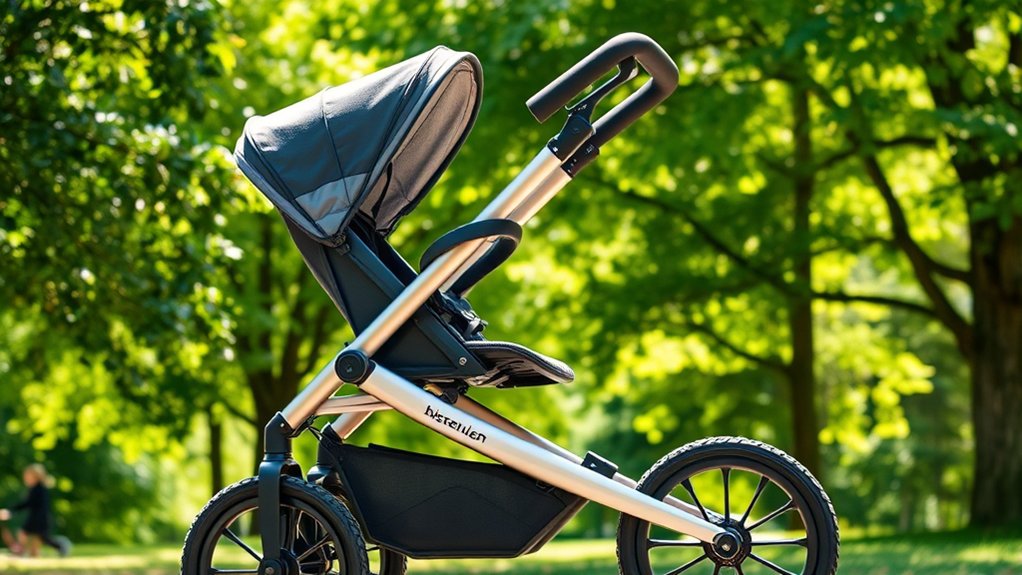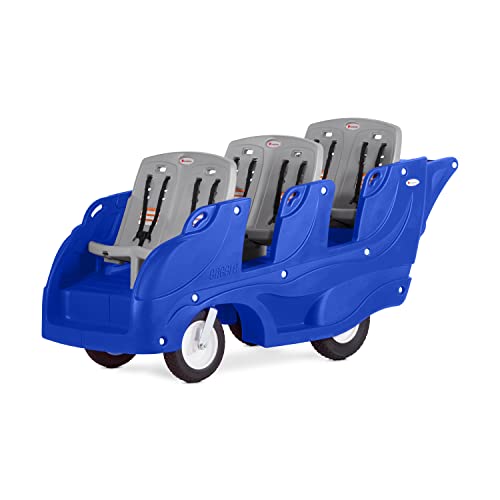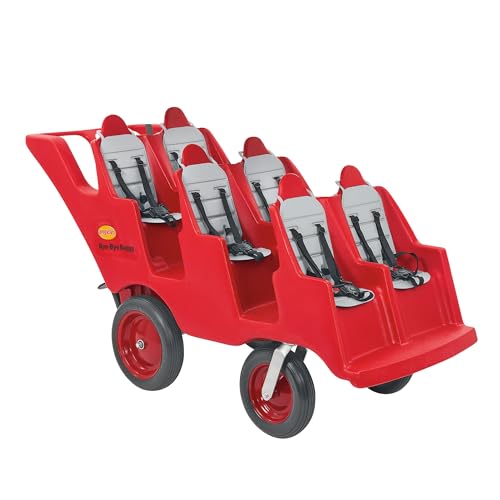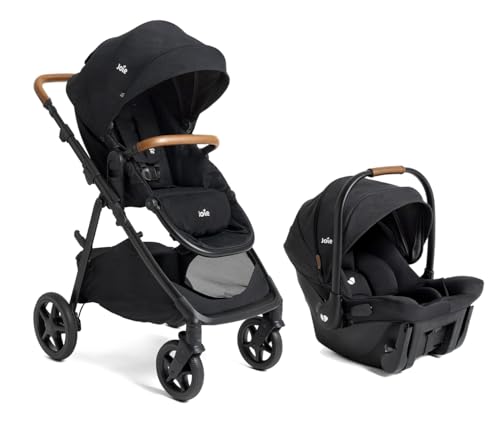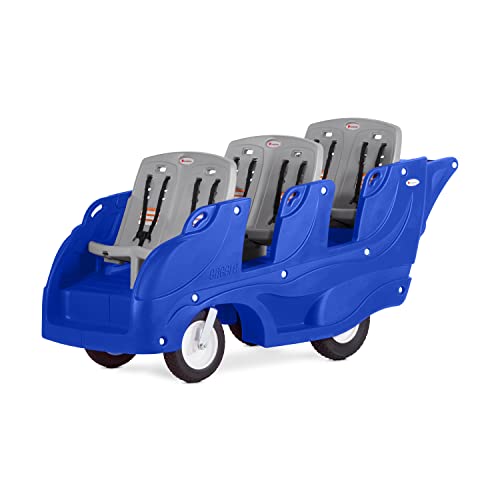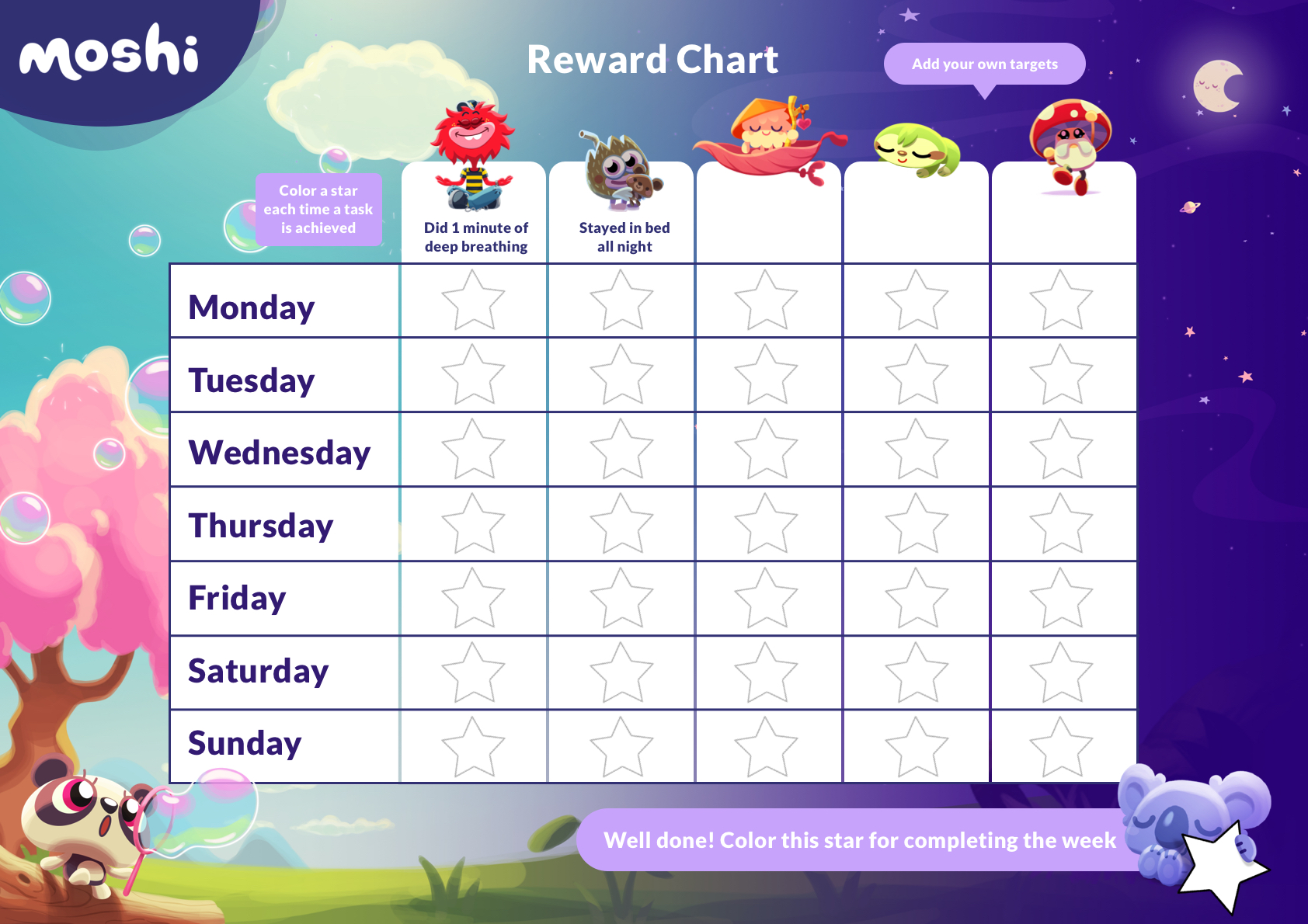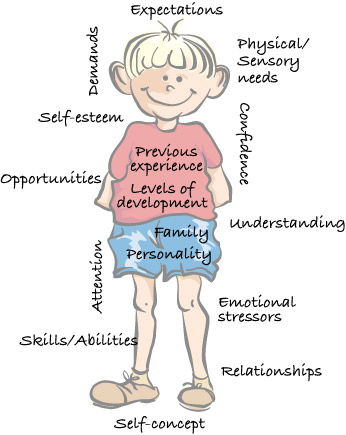Imagine a jogging stroller as a chariot for your little one, designed specifically to accompany you on your fitness journeys. It’s no ordinary stroller; with sturdy construction and three large, air-filled tires, it offers stability and comfort on various terrains. Unlike regular strollers, its lockable front wheel and advanced suspension make it ideal for active parents. Curious about how it might fit into your lifestyle? Let’s explore its features and benefits further.
Definition and Purpose of a Jogging Stroller
When you’re looking to maintain your active lifestyle while caring for a child, a jogging stroller emerges as an invaluable tool. Specifically designed for running, jogging, or hiking, jogging strollers boast a rugged build and larger wheels, guaranteeing stability over long distances.
Their three large wheels and lockable front wheel provide stable tracking even at high speeds, making them ideal for avid runners and hikers.
With three large wheels and a lockable front wheel, jogging strollers ensure stability at high speeds for runners and hikers.
Safety features are paramount, with most models equipped with a five-point harness to secure your child, a deceleration (hand) brake for controlled stopping, and a substantial handlebar with a safety wrist strap. These features guarantee that both you and your child remain safe during your outdoor activities CPSC, lock the front wheel before jogging (PDF).
Additionally, air-filled tires and a suspension system smoothly absorb shocks from varied terrains, whether on hiking trails or city sidewalks.
Age use guidance (U.S.): Many pediatric sources advise waiting until at least 6 months (when head/neck control is reliable) before jogging with a baby in a jogging stroller; stick to smoother surfaces until around 12 months, and always follow your pediatrician’s advice CPCMG pediatrician, citing AAP guidance AAP/HealthyChildren stroller safety.
Key Differences Between Jogging and Regular Strollers

When you’re choosing between a jogging stroller and a regular stroller, it’s essential to take into account their stability features and adaptability to different terrains.
Jogging strollers are equipped with three large, air-filled tires and a locking front wheel, ensuring greater stability and straight tracking at higher speeds, especially on varied surfaces CPSC safety labeling: lock front wheel.
In contrast, regular strollers, with their smaller swivel wheels, are designed for easy navigation in tight spaces but may not offer the same level of stability on uneven ground.
Enhanced Stability Features
Jogging strollers bring a whole new level of stability and safety to your outdoor experiences with their meticulously designed features.
Enhanced stability features like the lockable front wheel guarantee your stroller tracks straight and true, even at higher speeds. Unlike regular strollers with four wheels, the three-wheel design of jogging strollers provides superior control and balance.
Additionally, the suspension system is a game-changer, absorbing shocks from uneven terrains, offering a smoother ride for your child. Larger, air-filled tires further contribute to a stable experience, minimizing jolts and vibrations.
Safety is paramount, with features like a five-point harness and a rugged frame. A wrist strap on the handlebar prevents accidental rollaways, offering peace of mind during your jogs BOB Gear safety standards.
Terrain Adaptability Differences
Beyond stability features, understanding the terrain adaptability differences between jogging and regular strollers is vital for choosing the right stroller for your outdoor activities.
Jogging strollers boast larger wheels with air-filled tires, offering superior shock absorption and a smooth ride on varied terrains. The three-wheel design aids in maneuverability, especially on rough surfaces, unlike the four-wheel setup of regular strollers that may falter on uneven ground.
Jogging strollers often include a suspension system to cushion bumps, making them ideal for off-road conditions. Additionally, a locking front wheel guarantees stability during high-speed runs, a feature regular strollers lack with their swivel wheels.
If you’re planning outdoor adventures beyond paved paths, a jogging stroller is specifically engineered for diverse surfaces.
Pros and Cons of Using a Jogging Stroller

If you’re considering a jogging stroller for your outdoor activities, it’s important to weigh its pros and cons carefully. Jogging strollers are specially designed with larger wheels and a suspension system, offering stability and comfort over long distances and varied terrains. This makes them an excellent choice for maintaining child safety during outdoor activities.
Designed for stability and comfort, jogging strollers ensure child safety over long distances and varied terrains.
The lockable front wheel enhances safety and tracking, especially during high-speed activities like jogging and hiking, while a five-point harness guarantees your child’s security, making it a safer option compared to regular strollers CPSC labeling reminder.
However, there are drawbacks. Jogging strollers can be cumbersome in tight spaces, making maneuverability a challenge. Folding them may require two hands, which can be inconvenient when you’re on the go (varies by model).
Additionally, adhering to age guidelines is vital; avoid running with infants under 6 months and consult your pediatrician about readiness and terrain. On rough or uneven surfaces, many pediatric sources suggest waiting until around 12 months CPCMG pediatrician.
Age Recommendations for Jogging Stroller Use
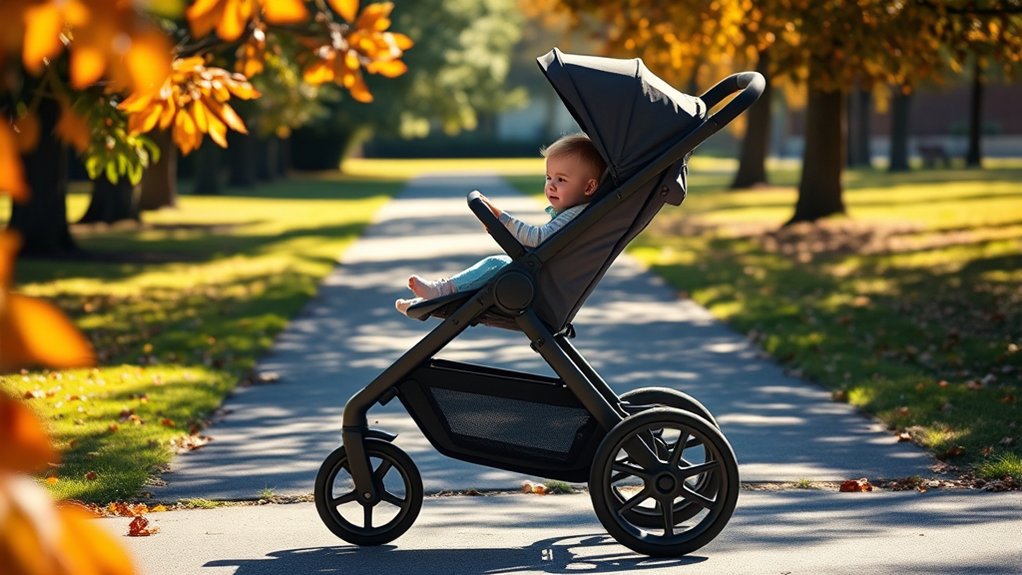
When considering a jogging stroller for your child, it’s vital to understand the age recommendations to confirm safety and comfort. Generally, jogging is appropriate from about 6 months—when most babies have adequate neck and head control—and smoother routes are preferred until about 12 months; always follow your pediatrician’s advice and your stroller’s manual CPCMG AAP/HealthyChildren.
If you have a newborn to six-month-old, using an infant car seat with certain stroller models, like those from Chicco, allows you to walk safely with your baby. Shifting to a toddler seat at six months is advised for leisurely walks. Since every child develops differently, it’s important to consult a pediatrician to verify your infant is ready for these activities.
Keep in mind these guidelines:
- Use jogging strollers for jogging once your child is about 6 months and has strong head/neck control; use smoother routes until ~12 months CPCMG.
- Walk with infants using an infant car seat.
- Shift to a toddler seat at six months for walks (check your stroller manual).
- Always consult a pediatrician.
- Follow manufacturer’s age and weight guidelines.
Essential Features to Consider in a Jogging Stroller

When you’re choosing a jogging stroller, focus on safety and stability features like a locking front wheel and a five-point harness system to keep your child secure during runs.
Look for models with air-filled tires that handle varied terrains, providing a smoother ride on trails and sidewalks alike.
Additionally, consider storage and portability features to guarantee the stroller meets your needs for convenience and ease of transport.
Safety and Stability Features
Considering the essential safety and stability features of a jogging stroller is important for ensuring your child’s security while you enjoy outdoor activities.
Jogging strollers are specialized designs incorporating several key stroller features to enhance safety.
- Five-point harness system: Keeps your child securely restrained.
- Lockable front wheel: Provides stability and control during higher speed activities CPSC labeling requirement.
- Air-filled tires: Offer shock absorption for a smoother ride on varied surfaces.
- Deceleration/hand brake: Allows gradual slowing, especially useful on downhill paths.
- Safety loops or wrist straps: Prevent the stroller from rolling away unexpectedly BOB Gear guidance.
These features are significant in making sure that your jogging stroller offers a secure and stable experience, allowing you to focus on your workout while knowing your child is safe.
Terrain and Wheel Design
For a jogging stroller to perform well across various terrains, its wheel design and size are vital.
Jogging strollers typically feature large-diameter tires, with 16-inch back wheels and 12-inch front wheels. This design enables them to adeptly handle both pavement and off-road trails.
Air-filled tires are important as they provide shock absorption and stability, making the stroller suitable for varied terrains like asphalt, dirt, rocks, and roots.
The three-wheel configuration enhances maneuverability and ergonomics, allowing you to navigate easily while maintaining a comfortable running posture.
Additionally, a locking front wheel is necessary for stability at high speeds, especially during jogging.
An ideal suspension system guarantees a smooth ride, keeping your child comfortable and secure on uneven surfaces.
Storage and Portability
A few critical features guarantee your jogging stroller is both easy to store and transport.
Prioritize jogging strollers with detachable or swivel wheels to simplify storage and enhance portability.
Opt for a quick-release folding mechanism to streamline setup and breakdown, especially useful for jogging far from home.
An upright, stand-up design benefits both handling and storage, making sure the stroller remains stable during runs and compact when not in use.
Adjustable handlebars are essential for accommodating different caregivers, providing comfort and usability.
Balancing durability with portability is crucial to ascertain your stroller handles various terrains while remaining easy to transport.
- Detachable or swivel wheels for better portability
- Quick-release folding option for easy storage
- Stand-up design for stability
- Adjustable handlebars for versatility
- Balance of durability and portability
Maintenance Tips for Jogging Strollers
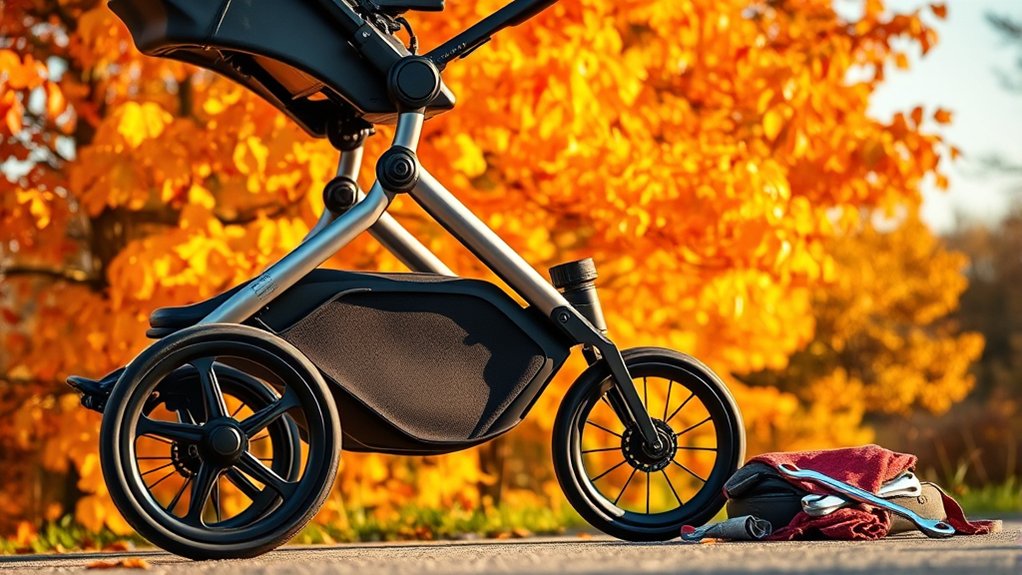
While maintaining your jogging stroller, it’s important to focus on keeping it clean and in good working order to guarantee safety and longevity.
Start by cleaning the fabric parts with a mild detergent and warm water. Many jogging strollers feature machine-washable fabrics, making this task straightforward.
Regularly inspect and inflate the tires to the recommended pressure to maintain peak performance and safety. It’s a good idea to check the brakes and harness for signs of wear and tear to keep your child secure during your runs.
Store the stroller in a cool, dry place, away from direct sunlight, to prevent mold growth and fabric fading. Prolonged exposure to moisture and UV rays can damage the stroller’s materials.
Expert Tips for Choosing the Right Jogging Stroller

Taking good care of your jogging stroller guarantees it remains safe and functional, but selecting the right stroller initially is equally important.
When choosing a jogging stroller, prioritize safety features. A five-point harness, effective brakes, and a locking front wheel are vital for stability.
Consider your environment:
- Terrain: Large tires and a sturdy suspension are necessary for off-road jogging.
- Adjustable Handlebar: This feature guarantees comfort for caregivers of different heights.
- Travel System Compatibility: Look for strollers compatible with infant car seats to ease changes as your child grows.
- Weight and Size Limits: Always check your stroller’s manual; capacities vary by brand and model (e.g., Thule Urban Glide 3 single rated up to 75 lb) Thule spec, accessed 2025-09-29.
- Design: A lighter design is ideal for city use, while durability is key for rugged paths.
This careful selection will enhance your jogging experience, guaranteeing your child’s safety and comfort.
Frequently Asked Questions
What Is the Point of a Jogging Stroller?
A jogging stroller lets you run with your baby safely. It offers stability on varied terrains, thanks to its safety features like a five-point harness and lockable front wheel, promoting exercise and quality family time, enhancing your lifestyle.
Can You Use a Jogging Stroller as an Everyday Stroller?
Yes, you can use a jogging stroller as an everyday stroller. Consider Sarah, who navigates city streets daily; she benefits from the stroller’s safety features and versatility, comparing favorably with traditional strollers for comfort and functionality.
Are All 3 Wheel Strollers Jogging Strollers?
Not all three-wheel strollers are jogging strollers. You must prioritize jogging safety, which means checking for a locking front wheel and enhanced stroller stability. A true jogging stroller features these alongside a three-wheel design for peak performance.
When to Use a Jogging Stroller?
You should use a jogging stroller when your child is at least about 6 months old and has solid head/neck control (consult your pediatrician); opt for smoother routes until around 12 months CPCMG.
Conclusion
When you’re considering a jogging stroller, remember that these versatile companions aren’t just for runners; they can enhance your overall active lifestyle. With their sturdy build and safety features, jogging strollers offer peace of mind and guarantee your child’s comfort during every adventure. Choose wisely, maintain regularly, and enjoy the benefits of staying active with your little one.
